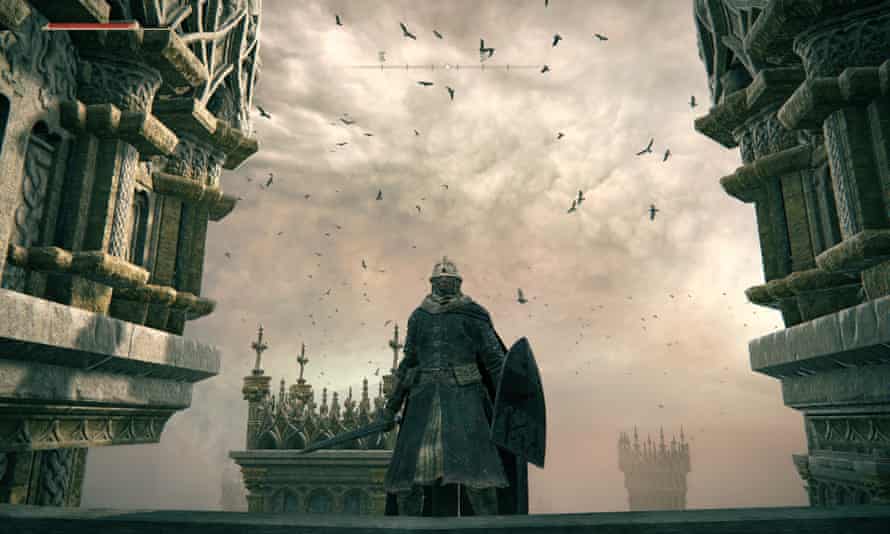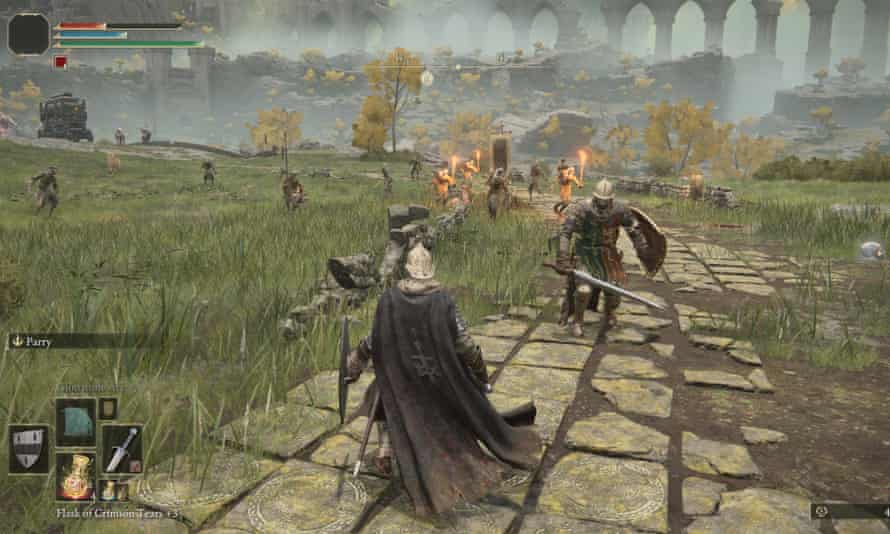Shared from www.theguardian.com.
Elden Ring has a Metacritic rating of 97%. If you type its name into Twitter you will be flooded with praise and anecdotes from players who have already spent many hours immersed in its arcane world. But what exactly is it? Why are people obsessed with it? And should you join them – or is it too hard?
So what is Elden Ring?
Elden Ring is the latest game from veteran Japanese studio FromSoftware, the creators of the critically acclaimed Souls series, which began with 2009’s Demon’s Souls and continued through the Dark Souls trilogy. It’s an open-world role-playing adventure set in a ravaged place known as the Lands Between, where the destruction of the titular artefact has led to wars and chaos. You play a warrior tasked with restoring the ring and becoming ruler of a new kingdom.
What do I do?
If you’ve played a Witcher or Elder Scrolls game, you’ll get it pretty quickly. Essentially, you will be exploring a vast kingdom filled with castles, caves and spooky dungeons, and fighting a menagerie of monsters from tiny imps to lumbering trolls and fire-breathing dragons. While doing this, you will also meet non-player characters who give you challenging quests and, if you’re lucky, valuable rewards.
As in classic tabletop role-playing games such as Dungeons & Dragons and Warhammer, your character has a mass of stats for health, strength, intelligence and so on, and can collect and customise weapons and spells to improve their combat skills. This inventory management element is much more complex than you’d see in, say, an Assassin’s Creed game: intricately defining your character and what they’re wearing to your own specific playing style is a major obsession for fans of FromSoftware’s games. You’ll also have to learn about concepts such as Super Armour, stance breaks, broken pots and critical hits, as well as things called Ashes of War, which add special powers to your armaments. It is a lot.
What’s so good about it?
A lot of people have said that Elden Ring is what The Legend of Zelda: Breath of the Wild would be if it hated you. That’s a pretty good analysis. It is a vast game with beautiful and diverse landscapes, a terrifying menagerie of monsters, and an incredibly deep levelling up system that rewards experimentation and personalisation. Director Hidetaka Miyazaki is a game-design genius who thinks deeply about games and how they function. There is always room for player interpretation, and the plotting is subordinate to interactivity. There are so many things to discover in the world that you find yourself constantly wanting to talk about it and compare experiences. I never really understood this with the Dark Souls trilogy but I get it now. With FromSoftware titles, you’re not just buying a game, you’re joining a community – a lot of the fun of the game is what happens outside of it.
Is it too hard?
No, it’s not. It’s just exacting and uncompromising. The major fights can never be won by charging in and waving your sword about. Video game soundtrack composer Christa Lee made a really interesting point on Twitter: she said the fights actually work more like turn-based battles from classic Japanese RPGs. You make your attack move, then you need to wait to see how the enemy responds, counter that with a parry or a dodge, then take your turn to strike again. It’s all about reading attack patterns, working out the best distance at which to engage the enemy, and ensuring you have the correct weapons and knowledge for the job. It’s easy to panic when faced with, say, a 20ft-high troll who can wipe your health bar with one swipe of his hammer. But when you figure out how slow that swipe is, you can concoct a plan of attack. The difference between Elden Ring and Dark Souls is that if you’re getting completely mugged in Elden Ring, you can usually just run away or ride off on your phantom horse. There is much more room for being useless.
And the good thing is, death isn’t all that expensive in Elden Ring: you’ll drop all your runes (the game’s currency) but, if you can get back to where you died without dying again, you can pick them up. Just make sure, in the early part of the game, you spend everything you make on weapons, recipe books for crafting and levelling up. Don’t hoard cash. Also, look for skulls with glowing eyes – they’re lying everywhere in the game world and they contain golden runes which aren’t lost when you die. It’s like having a credit card but, you know, more mysterious.
Also, as with other FromSoftware games, you can call in other players to help you with key encounters. Just use the game’s crafting system to make a Furlcalling Finger Remedy and strangers will be drawn to your location to give you a hand. There is also an important early item called Lone Wolf Ash, which provides you with a pack of spectral wolves who’ll attack your opponents and save you a lot of damage. Sometimes you can get different enemies to attack each other. I managed to wipe out almost all the soldiers guarding the Fort Haight by leading a couple of demi-human soldiers up to their position and letting them all fight it out. It was glorious.
However, the game is always ready to teach you a hard lesson. Margit the Fell Omen is the first major boss at the opening of the second section, Stormveil Castle, and he is an absolute beast with multiple devastating attack patterns. Don’t even think about it until your character hits level 20 and has seriously augmented weapons or an array of spells and incantations.

Can I just do my own thing?
Yes! Like Breath of the Wild, you are free to explore the entire map of Limgrave, and all the systems and objectives are discovered as you go, so it’s worth spending time just wandering around and investigating interesting things. There are no quest markers, no lists of side-tasks to tick off, no pictorial menus to endlessly flick between, no radio masts to switch on (I’m looking at you, Ubisoft). You go out and you interact with the world. I’ve had countless moments of discovery, from finding powerful weapons lying in swamps to battling giant crabs and descending into mines filled with rabid zombie dogs. For someone who struggled with the rigidity of the Dark Souls games, Elden Ring is a revelation.
Any last tips?
Find the weapons and armour that feel good for you. Experiment with swords, spears and bludgeoning weapons such as clubs and maces, and get to know which options work best on which enemies. Ranged combat is always a good tactic, so get into magic or use a bow.
Don’t forget to target enemies during fights (press down the right analogue stick). That is the only way you’ll hit them with arrows and throwing knives. Learn the jumping attack, where you jump on an enemy and slash them with your sword – it’s great for breaking their attack patterns, leaving them vulnerable to a followup. Practice the timing on softer foes.
Stay in the opening section Limgrave for as long as you can bear it before taking the next step into Stormveil Castle. You can do some serious levelling up, find lots of useful kit in the dungeons, and be much more prepared for the challenges to come.
Use guides. Eurogamer and GamesRadar both have in-depth guides to the game and they’ll clue you in on stuff you may have missed. If in doubt, get on an Elden Ring Discord or Reddit. The key lesson I’ve learned so far is that you never have to be alone in this game.
Images and Article from www.theguardian.com

